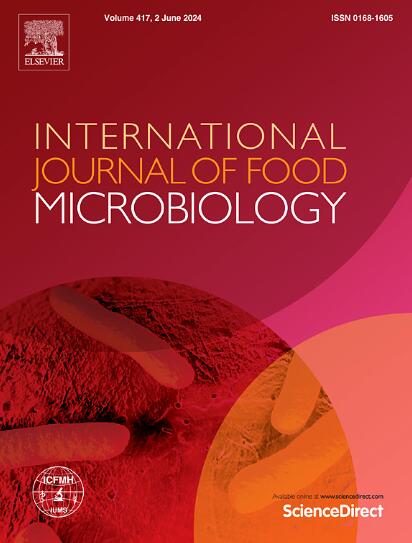The fate of spore-forming bacteria throughout the gelatin processing
IF 5.2
1区 农林科学
Q1 FOOD SCIENCE & TECHNOLOGY
International journal of food microbiology
Pub Date : 2025-07-21
DOI:10.1016/j.ijfoodmicro.2025.111355
引用次数: 0
Abstract
Gelatin is a natural protein soluble in water and extracted from animal collagen through thermal and chemical treatments. Its physicochemical properties make it valuable for various applications in the food and pharmaceutical industries. Ensuring its microbiological quality is essential for maintaining its properties and ensuring the safety of products that use it as a raw material. This study analyzed the concentrations of four groups of spore-forming microorganisms (aerobic mesophiles, presumptive Bacillus cereus, aerobic thermophiles, and anaerobic mesophiles) throughout all stages of gelatin processing at three seasons of the year (spring, summer, autumn). A total of 600 samples were collected from a single plant located in São Paulo, Brazil. The isolated microorganisms were identified through 16S rRNA gene sequencing. Significant differences in the concentrations of spores of these groups were observed and analyzed using ANOVA and PLS-DA methods. The highest log-reductions of spores were observed as follows: aerobic mesophiles showed a log-reduction of γ = 1.9 from the extrusion to the final product; B. cereus showed a log-reduction of γ = 1.9 from the raw material to the pre-washing; aerobic thermophiles had a log-reduction of γ = 1.6 from the raw material to the pre-washing; and anaerobic mesophiles had a log-reduction of γ = 1.1 from the concentrated tank to the sterilization. Sequencing identified B. cereus group members, B. licheniformis, Geobacillus sp., Clostridium sp., Lysinibacillus sp., and Brevibacillus sp. These findings are significant for industry, as some of these microorganisms produce toxins harmful to humans and contribute to product deterioration through the production of gelatinases.
孢子形成细菌的命运贯穿于明胶的整个加工过程
明胶是一种可溶于水的天然蛋白质,通过热和化学处理从动物胶原蛋白中提取。其物理化学性质使其在食品和制药工业中的各种应用具有价值。确保其微生物质量对于保持其特性和确保使用其作为原料的产品的安全性至关重要。本研究分析了在一年中的三个季节(春、夏、秋),在明胶加工的所有阶段中,四组形成孢子的微生物(好氧嗜温菌、假定的蜡样芽孢杆菌、好氧嗜热菌和厌氧嗜温菌)的浓度。从位于巴西圣保罗的一家工厂共收集了600个样本。通过16S rRNA基因测序对分离的微生物进行鉴定。采用方差分析(ANOVA)和PLS-DA分析方法观察和分析各组孢子浓度的显著差异。孢子对数减量最高的情况如下:从挤压到最终产物,好氧嗜中菌的对数减量为γ =−1.9;蜡样芽孢杆菌从原料到预洗过程中γ =−1.9,呈对数递减;好氧嗜热菌从原料到预洗的对数还原γ =−1.6;厌氧中温菌从浓缩池到灭菌过程中γ =−1.1的对数衰减。测序鉴定出蜡样芽孢杆菌、地衣芽孢杆菌、地杆菌、梭状芽孢杆菌、赖氨酸芽孢杆菌和短芽孢杆菌。这些发现对工业具有重要意义,因为这些微生物中的一些会产生对人类有害的毒素,并通过生产明胶酶导致产品变质。
本文章由计算机程序翻译,如有差异,请以英文原文为准。
求助全文
约1分钟内获得全文
求助全文
来源期刊
CiteScore
10.40
自引率
5.60%
发文量
322
审稿时长
65 days
期刊介绍:
The International Journal of Food Microbiology publishes papers dealing with all aspects of food microbiology. Articles must present information that is novel, has high impact and interest, and is of high scientific quality. They should provide scientific or technological advancement in the specific field of interest of the journal and enhance its strong international reputation. Preliminary or confirmatory results as well as contributions not strictly related to food microbiology will not be considered for publication.

 求助内容:
求助内容: 应助结果提醒方式:
应助结果提醒方式:


